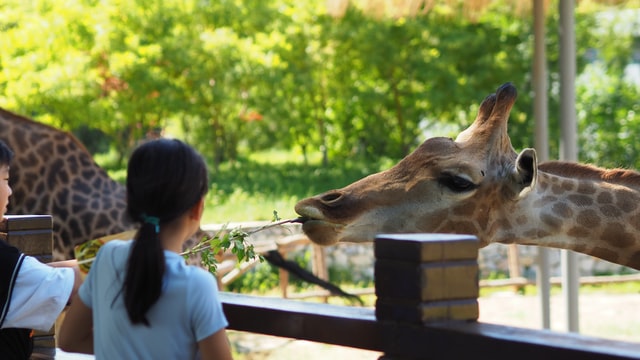Visiting the zoo is a wonderful experience for children and adults alike. Zoos offer exposure to animals from all around the world and are an incredible educational resource for communities. At the zoo, families can personally experience amazing animals and learn more about how human habits impact global ecosystems.
Over the last 100 years, zoos have shifted from a source of entertainment to accredited organizations fighting to protect endangered species. Zoos fund research, offer medical care to wounded animals and have even saved entire species from extinction. When you visit the zoo, you become part of this mission to respect and protect animal life.
Inspire Awe
In the United States, 83% of the population lives in cities. This means that a large majority of Americans are not connected to their natural environment. In cities, the most commonly observed animals are pets and vermin. Zoos are a refreshing reminder of the diversity of the planet and inspire awe in both children and adults.
Large zoos house a wide range of animals and often also serve as plant conservatories. By bringing many species together in one location, zoos remind visitors of the amazing diversity found across the planet. Zoos inspire curiosity, wonder and an emotional connection to nature that many modern Americans are missing.
Teach Responsibility
In addition to inspiring wonder, zoos are an amazing educational resource. Through their exhibit information and educational outreach programs, they explain the impact that human activities can have on animal life. Visitors are invited to learn more about their favorite species and how they can help protect them in the wild.
People can only act on what they know. Zoos help millions of people make the connection between mismanagement of resources, habitat loss and the extinction of valuable species. By visiting the zoo, you are contributing to the spread of information that inspires people to behave more responsibly toward the animal world.
Fund Research
Zoos also offer research opportunities for biologists, zoologists and other scientists interested in the natural world. If a scientist wants to study tigers in the wild, they have to locate them and then stalk them using the proper safety precautions. It’s much easier, safer and more effective to study an endangered species that’s living in a zoo.
Through research programs at zoos, scientists have learned more about how to keep animals healthy, both mentally and physically. They’ve studied diseases observed in the wild, nutrition and basic biology. This research equips zoological scientists to better care for animal populations around the world.
Make Memories
If you went to the zoo as a child, you might remember feeding a giraffe, watching meerkats pop out of their holes or eating ice cream while you laugh at the monkeys. These early memories build a positive emotional connection with nature that can influence people’s engagement with the environment for the rest of their lives.
Many zoos strive to create an immersive positive experience for visitors with good food, unique animal experiences and fun activities like rope courses and zip lines. Taking your kids to the zoo can be a source of good memories for the rest of their lives, but it also prepares them to become the next generation of environmental activists.
Offer Medical Care
Some zoos serve their region as wildlife rehabilitation centers. For example, Steve Irwin’s famous Australia Zoo has a fully functioning wildlife hospital. Since its inception, this hospital has cared for millions of animals injured through man-made causes or natural disasters.
Because they bring in profitable business, zoos can provide more resources for wildlife care than smaller organizations. They also offer employment to specialized vets who are able to gain experience with wildlife care and develop best practices for vets in the future.
Prevent Extinction
Zoos are one of many organizations working on the front lines to prevent species extinction. Through breeding programs and rehabilitation, zoos can protect endangered species and increase their population. Then, they work to reintroduce these animals into their natural habitat and watch over them until they’re stable.
The process isn’t perfect, mostly because rehabilitation can be incredibly challenging. However, many species have been successfully preserved for the future through zoo breeding programs. Examples include Przewalski’s horse from Mongolia, Amur leopards and Corroboree frogs. Species protection is an ongoing process that takes decades of dedicated work.
Protect Biodiversity
Visiting the zoo is an investment in biodiversity. That’s because every species matters – from the largest predator to the tiniest insect. Each creature brings something unique to its ecosystem and affects many other species. When one species goes extinct, repercussions are felt throughout its entire ecosystem.
As research and conservation centers, zoos have made it their mission to protect endangered animals and save as many species as possible from extinction. Although your day at the zoo is fun, it is also funding organizational efforts to protect life around the world.
Immerse Yourself in Nature
Not all zoos are created equal, so it’s important to ensure that your zoo is one of the good ones before you visit. However, many zoos are part of national or international organizations that set standards for appropriate animal care. You can check to see if your zoo is accredited and respected by zoologists.
Visiting the zoo is a wonderful experience for the whole family. The exhibits will inspire curiosity and awe in your children and teach them about their responsibility toward the natural world. By going to the zoo, you’re helping to fund valuable research and conservation efforts. A trip to the zoo combines family memories with protecting the Earth’s amazing biodiversity.

